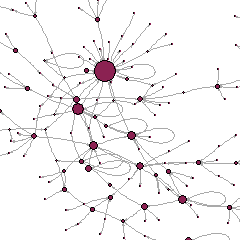Data visualization techniques are enjoying ever greater popularity, notably thank to the recent boom of Big Data and our increased capacity to handle large datasets. Network data visualization techniques are no exception. in fact, appealing diagrams of social connections (sociograms) have been at the heart of the field of social network analysis since the 1930s, and have contributed a lot to its success. Today, all this is evolving at unprecedented pace.
In line with these tendencies, the research team of the project ANAMIA (a study of the networks and online sociability of persons with eating disorders, funded by the French ANR) of which I was one of the investigators, have developed new software tools for the visualization of personal network data, with different solutions for the three stages of data collection, analysis, and dissemination of results.
Specifically:
– ANAMIA EGOCENTER is a graphical version of a name generator, to be embedded in a computer-based survey to collect personal network data. It has turned out to be a user-friendly, highly effective interface for interacting and engaging with survey respondents;
– ANAMIA CORPUS is for the analyst, more than the respondent or the general public. It enables to aggregate, organize and rank responses to a questionnaire containing personal network information about respondents;
– ANAMIA PERSONAL is also for the analyst (and to an extent, to the receptor of the study’s result) and offers a single format to represent individual network data consistently, to compare and contrast them; it identifies important alters and ties along relevant dimensions, comparable across respondents.
Interestingly, these tools mediate between classical research tools (surveys) and the specific challenges and opportunities of present-day Internet research. The ANAMIA data collected with them are still “small” with about 300 valid responses, but include a lot of complexity. On the one hand, personal network data collection is not easy, and the dropout rate is often high: ANAMIA EGOCENTER enables to alleviate this problem. On the other hand, the analysis of these data is not easy either, due to inclusion of the social contacts (alters) of each respondent (ego). So for 300 responses, we have information on about 4000 persons: ANAMIA CORPUS and PERSONAL are helpful in handling all this.
A seminar at the University of Greenwich next week, by Antonio A. Casilli and myself, discusses the usability of the three tools, with emphasis on potential future applications to a wider range of personal networks research, and the possible limitations.
CBNA seminar, Hamilton House, University of Greenwich, London
Friday 18 October 2013, 11.30 am – 1pm.

Great blog I enjoyedd reading